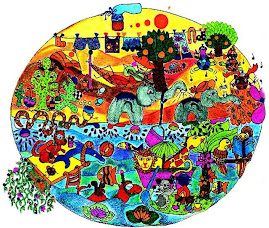
Saturday, November 3, 2007
Gender, water and sanitation
For a family of six, collecting enough water for drinking, cooking and basic hygiene may mean hauling heavy water containers from a distant source for an average of three hours a day. Women and girls are mainly responsible for fetching the water that their families need for drinking, bathing, cooking and other household uses (WHO/UNICEF, 2005: 11).
Poor health resulting from inadequate water and sanitation robs the children of schooling and the adults of earning power, a situation aggravated for the women and girls by the daily chore of collecting water (WHO/UNICEF, 2005: 11).
For pregnant women, access to enough good quality water is vitally important to protect them from serious diseases such as hepatitis (WHO/UNICEF, 2005: 20).
Women face the challenge of maintaining basic household hygiene and keeping their own and their infants’ hands and bodies clean with limited water supplies, and at the same time avoiding contamination of water stored for drinking and cooking (WHO/UNICEF, 2005: 20).
Currently, in sub-Saharan Africa, a larger proportion of women are infected with HIV than men. When women are living with HIV/AIDS, their suffering has a double impact on their families’ water problems (WHO/UNICEF, 2005: 21).
Adoption of sustainable hygiene behaviours is strongly linked to the educational level of women. Better-educated women are more likely to adopt long-term hygiene behaviours (WHO/UNICEF, 2005: 31).
1.3 billion women and girls in developing countries are doing without access to private, safe and sanitary toilets. In some cultural settings where basic sanitation is lacking, women and girls have to rise before dawn, making their way in the darkness to fields, railroad tracks and roadsides to defecate in the open, knowing they may risk rape or other violence in the process (WHO/UNICEF, 2004: 21).
The lack of adequate, separate sanitary facilities in schools is one of the main factors preventing girls from attending school, particularly when menstruating. Gender-sensitive school sanitation programmes can increase girls’ enrolment significantly. In Bangladesh girls’ enrolment was increased by as much as 11 per cent over a four-year period (UN-WWAP, 2006: 230), while in the Morocco Rural Water Supply and Sanitation Project of the World Bank school attendance in 6 provinces increased by even 20% in four years. Time spent on collecting water by women and young girls was reduced by 50 to 90% (World Bank, 2003).
Poor health resulting from inadequate water and sanitation robs the children of schooling and the adults of earning power, a situation aggravated for the women and girls by the daily chore of collecting water (WHO/UNICEF, 2005: 11).
For pregnant women, access to enough good quality water is vitally important to protect them from serious diseases such as hepatitis (WHO/UNICEF, 2005: 20).
Women face the challenge of maintaining basic household hygiene and keeping their own and their infants’ hands and bodies clean with limited water supplies, and at the same time avoiding contamination of water stored for drinking and cooking (WHO/UNICEF, 2005: 20).
Currently, in sub-Saharan Africa, a larger proportion of women are infected with HIV than men. When women are living with HIV/AIDS, their suffering has a double impact on their families’ water problems (WHO/UNICEF, 2005: 21).
Adoption of sustainable hygiene behaviours is strongly linked to the educational level of women. Better-educated women are more likely to adopt long-term hygiene behaviours (WHO/UNICEF, 2005: 31).
1.3 billion women and girls in developing countries are doing without access to private, safe and sanitary toilets. In some cultural settings where basic sanitation is lacking, women and girls have to rise before dawn, making their way in the darkness to fields, railroad tracks and roadsides to defecate in the open, knowing they may risk rape or other violence in the process (WHO/UNICEF, 2004: 21).
The lack of adequate, separate sanitary facilities in schools is one of the main factors preventing girls from attending school, particularly when menstruating. Gender-sensitive school sanitation programmes can increase girls’ enrolment significantly. In Bangladesh girls’ enrolment was increased by as much as 11 per cent over a four-year period (UN-WWAP, 2006: 230), while in the Morocco Rural Water Supply and Sanitation Project of the World Bank school attendance in 6 provinces increased by even 20% in four years. Time spent on collecting water by women and young girls was reduced by 50 to 90% (World Bank, 2003).
FACTSHEET ON WATER AND SANITATION
Meeting Global Targets for Water and Sanitation
There are 1.1 billion people, or 18 per cent of the world's population, who lack access to safe drinking water. About 2.6 billion people, or 42 per cent of the total, lack access to basic sanitation (WHO/UNICEF, 2005 : 40)
The Millennium Development Goals (MDGs) call for halving "by 2015, the proportion of people without sustainable access to safe drinking water and basic sanitation." The MDG for safe drinking water on a global scale appears likely to be reached, in most regions, with the exception of sub-Saharan Africa (WHO/UNICEF, 2005 : 26).
Within the United Nations system, UN-Water is the inter-agency mechanism that coordinates the activities of 24 agencies of the United Nations system in the area of water resources, including sanitation.
1.1 billion people gained access to safe drinking water between 1990-2002. The greatest access gains were achieved in South Asia , where water access increased from 71 per cent in 1990 to 84 per cent in 2002. In sub-Saharan Africa , access grew minimally, from 49 percent in 1990 to 58 per cent in 2002. (WHO/UNICEF, 2004 : 10).
IIt is estimated that an additional investment of US$ 11.3 billion per year would be needed to achieve the MDGs for drinking water and sanitation at the most basic levels WHO/UNICEF, 2005 : 2)
There are 1.1 billion people, or 18 per cent of the world's population, who lack access to safe drinking water. About 2.6 billion people, or 42 per cent of the total, lack access to basic sanitation (WHO/UNICEF, 2005 : 40)
The Millennium Development Goals (MDGs) call for halving "by 2015, the proportion of people without sustainable access to safe drinking water and basic sanitation." The MDG for safe drinking water on a global scale appears likely to be reached, in most regions, with the exception of sub-Saharan Africa (WHO/UNICEF, 2005 : 26).
Within the United Nations system, UN-Water is the inter-agency mechanism that coordinates the activities of 24 agencies of the United Nations system in the area of water resources, including sanitation.
1.1 billion people gained access to safe drinking water between 1990-2002. The greatest access gains were achieved in South Asia , where water access increased from 71 per cent in 1990 to 84 per cent in 2002. In sub-Saharan Africa , access grew minimally, from 49 percent in 1990 to 58 per cent in 2002. (WHO/UNICEF, 2004 : 10).
IIt is estimated that an additional investment of US$ 11.3 billion per year would be needed to achieve the MDGs for drinking water and sanitation at the most basic levels WHO/UNICEF, 2005 : 2)
Subscribe to:
Posts (Atom)








